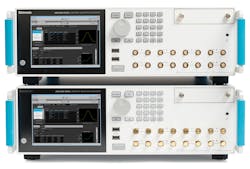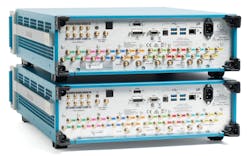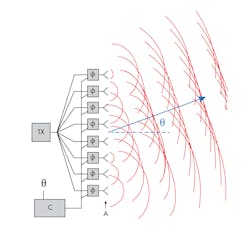When a company calls and says they have the best widget ever, you have to be skeptical. However, you also can’t help but be curious. When they talked about how it would advance the state of the art in radar, electronic warfare, and quantum-computing test, and make an engineer’s workspace tidier, I was smitten.
I met up with the Tektronix team, led by Product Market Manager Kip Pettigrew, and wasn’t disappointed: The new AWG5200 arbitrary waveform generator is a work of art and function. Physically, it’s both commanding and imposing. It measures 18.13 × 6.05 from the front, but it’s 23.76 inches deep—so, while it’ll sit nicely within a test stack and help reduce clutter, the stack had better have a deep shelf (Figs. 1 and 2).
It’s what’s within those dimensions, and what you have to pay to get it, though, that give the AWG5200 a certain level of gravitas. For sure, it’s hard to ignore a price point of $82,000, but it’s not surprising when you understand what you’re getting in return.
1. The AWG5200 measures 18.13 × 6.05 and comes with a 6.5-inch touchscreen, a removable hard drive (upper right), and two, four, or eight channels (bottom right). (Source: Tektronix)
Aimed squarely at military/government and advanced research applications, the system emphasizes signal fidelity, scalability, and flexibility. It can accurately reproduce complex, real-world signals across an ever-expanding array of applications without having to physically expand a test area. It’s also supported by Tektronix’s SourceXpress software, which lets you create waveforms and control the AWGs remotely, and has a growing library of waveform-creation plugins.
2. The AWG5200 is designed to be compact so that it can stack easily with other equipment to reduce overall space requirements, though it is 23.76 inches deep. A synchronization feature allows it to scale up beyond eight channels by adding more AWG5200s. (Source: Tektronix)
Let the Specs Tell the Story
Digging into the specs uncovers what the AWG5200 is all about. Words like powerful, precision, and solid engineering come to mind. The system can sample at 5 Gsamples/s (10-Gsamples/s with interpolation) with 16-bit vertical resolution across two, four, or eight channels per unit. Channel-to-channel skew (typical) is <25 ps with a range of ±2 ns and a resolution of 0.5 ps. The analog bandwidth is 2 GHz at ‒3 dB) or 4 GHz at ‒6 dB, and the amplitude range is 100 to 0.75 V p-p, with an accuracy of ±2% of setting.
The AWG5200’s multi-unit synchronization feature helps scale up beyond eight channels. Note that each channel is independent, so the classic tradeoff of sample memory for bandwidth doesn’t apply here. Each channel gets 2 Gsamples of waveform memory.
The precision is embodied within its ability to generate RF signals with a spurious-free dynamic range (SFDR) of ‒70 dBc. Combined with a software suite and support, this is critical as new waveforms and digital-modulation techniques are explored in a time of rapid wireless evolution in military and government applications, as well as 5G and even quantum-computer test. Signal fidelity isn’t something you want to worry about, and the expanding library and customizable features help kickstart and then fine-tune your research and development waveforms.
How’d They Do That?
Achieving higher or improved specifications is almost always a “labor of love”: The test company’s engineers’ constant urge to make things better combines with customer feedback and an analysis of where to focus energy and development to have the most impact. However, at a fundamental level, the AWG5200’s advances go back to the digital-to-analog converter (DAC) technology at the heart of the system.
Advances in DAC technologies, particularly with respect to signal processing and functional integration, allow them to directly generate detailed and complex RF and electronic-warfare (EW) signals. This is an area worth digging into in more detail, so Christopher Skach and Sahandi Noorizadeh developed a feature specially for Electronic Design on DAC technology advances and how it’s changing signal generation for test. It’s worth a look.
Rapidly Evolving Applications
Pettigrew also provided a quick run through of the newer and more interesting applications, as well as the key market trends that the system is solving for. In general electronic test, “go wide” technologies like MIMO need test systems that can scale as they need multiple, independent, wide-bandwidth RF streams (Fig. 3).
3. Rapid expansion in the use of techniques such as MIMO requires more advanced and flexible waveform generators to generate multiple high-fidelity, RF signals with complex modulation schemes. (Source: Tektronix)
This translates over to mil/gov, too, where systems must be tested for their ability to detect and respond to adaptive threats. The signals of interest are able to be generated on two channels, while the others can be used to generate expected noise, Wi-Fi interferers, and other MIMO channels.
However, just being able to reproduce the signals isn’t enough: The AWG must be capable of enabling stress and margin testing, as well as verification and characterization.1
On the research front, it turns out that quantum computing needs advanced AWGs, too, said Pettigrew, as they lack the fidelity, latency, and scalability. In quantum computers, the qubits are often controlled using precision-pulsed microwave signals, each requiring multiple independent RF channels. This is only going to get more interesting and challenging as companies like IBM and Google, along with many independent physicists and engineers, work to scale up quantum-computing technology and applications.
For all three of these applications, cost remains a factor. So, instead of developing multiple custom solutions, the AWG5200 may be a good commercial off-the-shelf (COTS) option.
References:
1. How New DAC Technologies are Changing Signal Generation for Test




